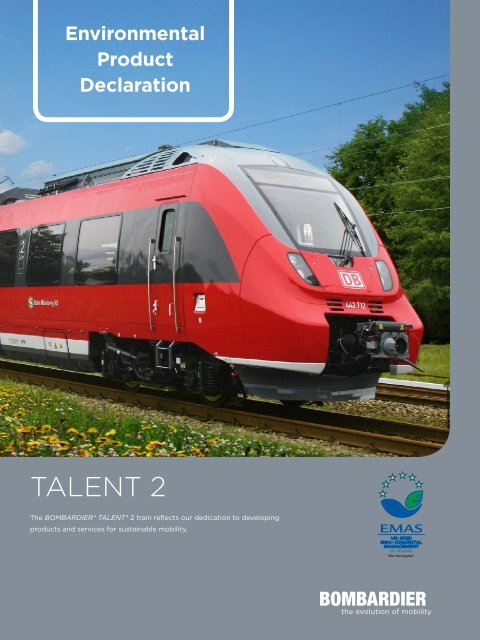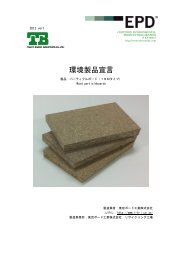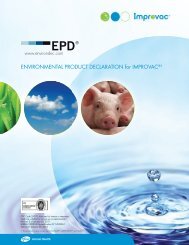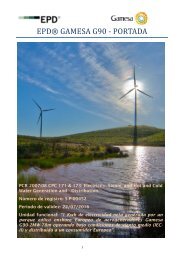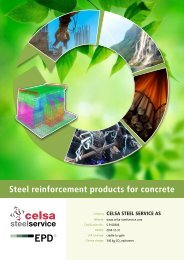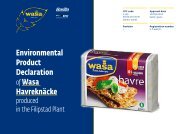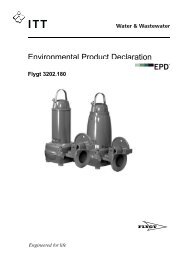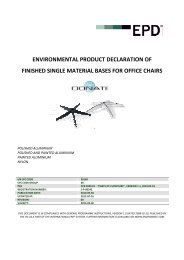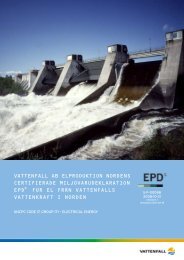TALENT 2 - The International EPD® System
TALENT 2 - The International EPD® System
TALENT 2 - The International EPD® System
You also want an ePaper? Increase the reach of your titles
YUMPU automatically turns print PDFs into web optimized ePapers that Google loves.
Environmental<br />
Product<br />
Declaration<br />
<strong>TALENT</strong> 2<br />
<strong>The</strong> BOMBARDIER* <strong>TALENT</strong>* 2 train reflects our dedication to developing<br />
products and services for sustainable mobility.<br />
Site Hennigsdorf
<strong>TALENT</strong> 2<br />
Designed for Sustainable Mobility<br />
Material Content<br />
<strong>The</strong> <strong>TALENT</strong> 2 train is developed with a strong emphasis<br />
on our commitment to eliminating hazardous substances<br />
and related toxic emissions, providing a safer environment<br />
for our customers, passengers and employees. <strong>The</strong><br />
Bombardier Controlled Substances list enables product<br />
designers to screen out such substances by identifying<br />
them throughout our supply chain and actively working<br />
towards eliminating them from our vehicles.<br />
Material [kg] Manufacturing Maintenance Total<br />
Metals 119 020,6 20 184,5 139 207,7<br />
Energy Efficiency<br />
Regenerative braking, an energy-optimized parking<br />
concept and an optional electronic support of the driver<br />
for energy saving operation contribute to maximizing<br />
the energy efficiency of the <strong>TALENT</strong> 2 NUE train at<br />
6,35 kWh/km. Track energy consumption data is based<br />
on a test run on the Deutsche Bahn track between Nauen<br />
and Neustadt/Dosse in typical suburban traffic with<br />
3 stops. Assumptions on vehicle auxiliary systems load<br />
is based on EC Contract No. FP6-031458. <strong>The</strong> passenger<br />
load is at 50% giving 111 passengers per trainset.<br />
<strong>The</strong> <strong>TALENT</strong> 2 train sets a high standard for environmentally<br />
sustainable rail transportation. This Environmental<br />
Product Declaration provides a detailed insight<br />
into the environmental impact of the <strong>TALENT</strong> 2 train<br />
as the principles and procedures of ISO 14025:2006.<br />
EPDs are part of the BOMBARDIER* ECO4* product<br />
portfolio. <strong>The</strong>y are based on Life Cycle Assessment<br />
methodology and function as an externally validated<br />
Polymers 5 120,5 5 423,6 10 544,1<br />
Elastomers 1 826,6 258,9 2 085,5<br />
Glass 2 527,0 419,7 2 946,8<br />
Fluids 1 716,7 1 616,0 3 332,7<br />
MONM 2 691,3 380,6 3 071,9<br />
Others 3 952,7 7 570,7 11 523,4<br />
Total 136 855,3 35 854,2 172 712,1<br />
<strong>The</strong> <strong>TALENT</strong> 2 NUE material composition and all material required<br />
for maintenance during a 32 year operation. Materials are classified<br />
according to ISO 22628:2002.<br />
Grams CO 2<br />
equivalents / passenger-km<br />
120<br />
100<br />
80<br />
60<br />
40<br />
20<br />
0<br />
<strong>TALENT</strong> 2<br />
car<br />
(petrol)<br />
car<br />
(diesel)<br />
bus<br />
throughout its complete life cycle.<br />
communication tool, providing complete transparency to<br />
<strong>The</strong> following chart shows an allocation of the<br />
Communicating Environmental<br />
Performance – ISO 14025<br />
We communicate the environmental performance of our<br />
products through Environmental Product Declarations<br />
(EPDs) following the international EPD® system. Our<br />
EPDs are developed in line with the UNIFE Product<br />
Category Rules for Rail Vehicles (PCR 2009:05) as well<br />
the benefit of our customers and other stakeholders. <strong>The</strong><br />
external validation is carried out by independent verifiers<br />
approved by the technical committee of the international<br />
EPD® system and/or the EU Eco-management and Audit<br />
Scheme (EMAS).<br />
<strong>The</strong> Nuremberg 4-car trainset configuration of the<br />
<strong>TALENT</strong> 2 train forms the basis of the specific environmental<br />
information of this EPD (<strong>TALENT</strong> 2 NUE).<br />
<strong>TALENT</strong> 2 NUE total vehicle mass to the five main<br />
product groups identified in PCR 2009:05, version 1.1 1 .<br />
22%<br />
3%<br />
39%<br />
When compared to travelling by car or bus up to 71% of the resulting<br />
fossil CO 2<br />
emissions per passenger/km could be avoided 2 .<br />
Noise<br />
<strong>The</strong> <strong>TALENT</strong> 2 train is homologated according to TSI CR<br />
Noise (2006), see limits shown in the table below. <strong>The</strong><br />
limits for noise are defined at a distance of 7,5 m from the<br />
center of the track and 1,2 m above the top of the rail.<br />
Noise<br />
dB(A)<br />
<strong>TALENT</strong> 2 - Highlighted facts and figures<br />
Number of cars 4<br />
Weight<br />
136 855 kg<br />
Capacity<br />
221 seats<br />
Max speed<br />
160 km/h<br />
Energy consumption<br />
6,35 kWh/km<br />
Recoverability/ Recyclability 96% / 92%<br />
Data is based on the <strong>TALENT</strong> 2 Nuremberg configuration.<br />
22%<br />
Carbody 53185 kg<br />
Interior, windows and doors 19270 kg<br />
Bogies and running gear 30528 kg<br />
Propulsion and electric equipment 30353 kg<br />
Comfort systems 3520 kg<br />
14%<br />
<strong>The</strong> <strong>TALENT</strong> 2 NUE modular structure according to PCR 2009:05,<br />
version 1.1.<br />
Standstill noise < 68<br />
Starting noise < 82<br />
Pass-by noise at 80 km/h < 81<br />
Pass-by noise at 160 km/h < 90<br />
1<br />
Product Category Rules (PCR) for preparing an Environmental<br />
Product Declaration (EPD) for Rail Vehicles, UNCPC CODE: 495,<br />
PCR 2009:05, version 1.1, <strong>International</strong> EPD Consortium (IEC).<br />
2<br />
UmweltMobilCheck: Internet tool to compare the emissions and<br />
energy consumption of different transport modes for passenger<br />
transport in Germany - Scientific Report; commissioned by<br />
Deutsche Bahn AG, 2008.<br />
2<br />
<strong>TALENT</strong> 2 – Environmental Product Declaration<br />
3
A Life Cycle Perspective<br />
Environmental Profile of the <strong>TALENT</strong> 2<br />
Raw material extraction<br />
Manufacturing<br />
End of life<br />
Operation<br />
Carbon Footprint<br />
Greenhouse gas (GHG) emissions throughout the<br />
<strong>TALENT</strong> 2 NUE train life cycle are as low as 38,60 g of<br />
CO 2<br />
equivalents when allocated to one passenger<br />
travelling for one km.<br />
Grams CO 2<br />
equivalents / passenger-km<br />
50<br />
45<br />
40<br />
35<br />
30<br />
25<br />
20<br />
15<br />
10<br />
5<br />
0<br />
0,99<br />
0,67<br />
36,91<br />
Raw material extraction<br />
and component production<br />
0,03<br />
38,60<br />
Total<br />
Use<br />
Energy and Material Resource Use<br />
Renewable and non-renewable energy and material<br />
resource use throughout the <strong>TALENT</strong> 2 train life cycle is<br />
detailed in the following charts as a percentage of the<br />
total for the entire life cycle of the vehicle. <strong>The</strong> distinction<br />
between renewable and non-renewable energy and<br />
material resources is shown with green shades representing<br />
renewable resources and grey shades representing<br />
non-renewable resources.<br />
7,37%<br />
21,63%<br />
10,54%<br />
8,80%<br />
23,88%<br />
0,05%<br />
Final assembly<br />
End of life<br />
At Bombardier life cycle thinking is integrated to the<br />
design process, highlighting the significance of different<br />
design choices and the true overall environmental<br />
impact these choices have.<br />
Life Cycle Assessment<br />
Power supply<br />
Electric power to Deutsche Bahn AG rail vehicles is<br />
sourced primarily from hard coal and nuclear energy.<br />
<strong>The</strong> Deutsche Bahn AG power supply mix for 2009 was<br />
used to model the operation phase of the <strong>TALENT</strong> 2<br />
train life cycle.<br />
Contribution of each life cycle phase to the total mass of CO 2<br />
equivalents.<br />
Recyclability and Recoverability<br />
Using materials featuring high recyclability and considering<br />
disassembly early in the design phase maximise<br />
the overall recoverability of the <strong>TALENT</strong> 2 train. Material<br />
recycling and energy recovery aggregate to give a 96%<br />
1,09%<br />
Hydro power<br />
Wind power<br />
Crude oil<br />
Uranium<br />
26,65%<br />
Others<br />
Hard coal<br />
Lignite<br />
Natural gas<br />
Energy resource use throughout the <strong>TALENT</strong> 2 NUE life cycle<br />
shown as a percentage of the total calorific value.<br />
Resource efficiency, waste generation and overall<br />
recoverability rate.<br />
environmental impact are estimated throughout all life<br />
cycle phases of the <strong>TALENT</strong> 2 NUE train, following ISO<br />
14040:2006 methodology. 3 <strong>The</strong> results are based on a<br />
4-car <strong>TALENT</strong> 2 train in service for 32 years, with an<br />
average running distance of 250 000 km per year. All<br />
13%<br />
9%<br />
2%<br />
32%<br />
4%<br />
4%<br />
assumptions on vehicle auxiliary systems load are based<br />
on EC Contract No. FP6-031458, following the methodology<br />
and operational profiles used for the energy con-<br />
44,19%<br />
30,4%<br />
sumption simulation. <strong>The</strong> simulated operational scenarios<br />
features 80% energy recovery from regenerative braking.<br />
18%<br />
<strong>The</strong> end of life phase of the life cycle is modeled accord-<br />
92%<br />
13,7%<br />
ing to technology available today. <strong>The</strong> potential benefit<br />
25%<br />
from material recycling and energy recovery is not<br />
included in the environmental impact tables.<br />
3<br />
Bombardier document: 3EST7–3295 Life Cycle Assessment of the<br />
<strong>TALENT</strong> 2 train for Nürnberg suburban electrical multiple unit train.<br />
Hard Coal<br />
Nuclear Energy<br />
Renewable Energy<br />
Brown Coal<br />
Natural Gas<br />
Other Fuels<br />
Material Recycling<br />
Residues/Disposal<br />
Energy Recovery<br />
Water<br />
Air<br />
11,7%<br />
Inert rock<br />
Metal ores<br />
Power supply for the <strong>TALENT</strong> 2 NUE train resulting in emissions of<br />
500 g of CO 2<br />
equivalents per kWh.<br />
Projected recoverability at the end of life phase of the <strong>TALENT</strong> 2 NUE,<br />
following ISO 22628 methodology.<br />
Material resource use throughout the <strong>TALENT</strong> 2 NUE life cycle shown<br />
as a percentage of the total material resource mass.<br />
4<br />
<strong>TALENT</strong> 2 – Environmental Product Declaration<br />
5
Environmental Impact in Detail<br />
Renewable resources<br />
Upstream module Core module Downstream module Total<br />
Raw material extraction<br />
and component production<br />
Final assembly Use End of life<br />
Material [kg/pass. km] 1,59E-02 1,03E-02 5,63E-01 2,56E-04 5,90E-01<br />
Water 1,04E-02 7,36E-03 3,89E-01 1,02E-04 4,07E-01<br />
Air 5,53E-03 2,94E-03 1,74E-01 1,54E-04 1,83E-01<br />
Carbon dioxide 1,32E-05 1,46E-06 1,27E-05 2,66E-08 2,74E-05<br />
Others 2,71E-07 6,70E-12 4,61E-07 1,65E-14 7,32E-07<br />
Energy [MJ/pass.km] 1,22E-03 5,14E-04 1,04E-01 5,99E-06 1,06E-01<br />
Hydropower 8,97E-04 2,24E-04 2,07E-02 2,65E-06 2,18E-02<br />
Biomass 1,08E-06 0,00E+00 2,15E-06 0,00E+00 3,23E-06<br />
Wind power 7,10E-05 2,53E-04 8,34E-02 2,98E-06 8,37E-02<br />
Solar energy 1,30E-04 2,24E-05 1,26E-04 3,62E-07 2,79E-04<br />
Others 1,17E-04 1,47E-05 2,85E-05 2,18E-09 1,60E-04<br />
Non-renewable resources<br />
Material [kg/pass.km] 2,31E-02 1,37E-02 7,14E-01 3,00E-04 7,51E-01<br />
Inert rock 5,01E-03 3,40E-03 1,49E-01 4,14E-05 1,57E-01<br />
Natural aggregate 4,93E-06 4,70E-06 2,36E-04 3,41E-07 2,46E-04<br />
Copper ores 1,49E-03 1,32E-07 5,63E-04 1,56E-09 2,05E-03<br />
Metal ores 1,66E-02 1,03E-02 5,64E-01 2,58E-04 5,91E-01<br />
Energy (MJ/pass.km) 1,23E-02 9,78E-03 6,39E-01 1,31E-04 6,62E-01<br />
Uranium 1,87E-03 3,85E-03 2,48E-01 4,61E-05 2,54E-01<br />
Crude oil 2,74E-03 1,66E-04 7,49E-03 1,15E-05 1,04E-02<br />
Hard coal 4,18E-03 2,26E-03 2,21E-01 2,80E-05 2,27E-01<br />
Lignite 7,77E-04 2,55E-03 9,69E-02 3,11E-05 1,00E-01<br />
Natural gas 2,69E-03 9,49E-04 6,65E-02 1,44E-05 7,01E-02<br />
Waste<br />
Waste [kg/pass.km] 7,72E-03 3,43E-03 1,50E-01 5,46E-05 1,61E-01<br />
Hazardous waste 3,34E-05 4,09E-06 9,79E-05 2,67E-06 1,38E-04<br />
Non-hazardous waste 7,68E-03 3,43E-03 1,50E-01 5,19E-05 1,61E-01<br />
Environmental impact categories (pass.km)<br />
Acidification Potential (AP) [kg SO 2<br />
-Equiv.] 5,00E-06 1,08E-06 5,72E-05 2,39E-08 6,34E-05<br />
Eutrophication Potential (EP) [kg Phosphate-Equiv.] 4,40E-07 1,36E-07 5,29E-06 2,96E-09 5,87E-06<br />
Global Warming Potential (GWP 100 years) [kg CO 2<br />
-Equiv.] 9,87E-04 6,67E-04 3,69E-02 3,08E-05 3,86E-02<br />
Ozone Layer Depletion Potential (ODP, steady state) [kg R11-Equiv.] 5,23E-11 1,03E-10 6,69E-09 1,24E-12 6,85E-09<br />
Ozone Creation Potential (POCP) [kg Ethene-Equiv.] 4,32E-07 1,56E-07 4,32E-06 1,65E-09 4,91E-06<br />
Definitions<br />
Acidification potential<br />
<strong>The</strong> aggregate measure of the acidifying potential of some substances,<br />
calculated through the conversion factor of sulphur oxides and<br />
nitrogen and ammonia into acidification equivalents (H + ion).<br />
Carbon footprint<br />
<strong>The</strong> carbon footprint of a passenger travelling for one km is the result<br />
of an allocation of the total amount of greenhouse gases (GHG)<br />
emitted over all phases of the vehicle life cycle. <strong>The</strong> total mass of<br />
emitted GHGs is allocated to CO 2<br />
equivalents.<br />
Eutrophication potential<br />
<strong>The</strong> aggregate measure of the inland water eutrophication potential of<br />
some substances, calculated through the conversion factor of phosphorous<br />
and nitrogen compounds (waste water discharges and air<br />
emissions of NO x<br />
and NH 3<br />
) into phosphorous equivalents.<br />
Global warming potential<br />
<strong>The</strong> aggregate measure of the contribution to the greenhouse effect<br />
of some gases through their conversion into carbon dioxide equivalents.<br />
Life cycle assessment<br />
Life cycle assessment (LCA) is a technique assessing the environmental<br />
impact associated with all stages of a product's life from-cradle-tograve<br />
(i.e., from raw material extraction through materials processing,<br />
manufacturing, distribution, use, repair and maintenance, and disposal<br />
or recycling).<br />
Ozone layer depletion potential<br />
<strong>The</strong> aggregate measure of the ozone layer depleting potential of some<br />
substances, calculated through the conversion factor of halogenated<br />
hydrocarbons that contribute to the depletion of the ozone layer into<br />
CFC -11 equivalents.<br />
Photochemical ozone creation potential<br />
<strong>The</strong> aggregate measure of the ground level ozone creation potential<br />
of some substances, calculated through the conversion factor of<br />
ethylene equivalents that contribute to the formation of photochemical<br />
oxidants.<br />
Recyclability and recoverability<br />
<strong>The</strong> recyclability and the recoverability rate of a new rail vehicle are<br />
expressed as a percentage by mass of the rail vehicle that can potentially<br />
be recycled, reused or both (recyclability rate), or recovered,<br />
reused or both (recoverability rate).<br />
6<br />
<strong>TALENT</strong> 2 – Environmental Product Declaration<br />
7
Design for Environment<br />
<strong>The</strong> integration of environmental sustainability into<br />
product development is fundamental at Bombardier,<br />
where it has a core function in designing state of the<br />
art rail transportation equipment.<br />
PCR review was conducted by the technical<br />
committee of the international EPD® system:<br />
Joakim Thornéus (Chair)<br />
Swedish Environmental Management Council<br />
email: joakim@environdec.com<br />
Applying a complete life cycle perspective to vehicle<br />
design is central to our product responsibility strategy.<br />
Maximising energy and resource efficiency, eliminating<br />
hazardous substances and related toxic emissions as<br />
well as enhancing the overall product recyclability rate<br />
is the result of a high quality working process applied to<br />
product design and cascaded down our supply chain. <strong>The</strong><br />
Bombardier Transportation Design for Environment (DfE)<br />
Centre of Competence, together with the DfE expert<br />
network, acts as a catalyst by providing the essential tools,<br />
expertise and central coordination in projects worldwide.<br />
More information on Design for Environment and Environmental<br />
Product Declarations at Bombardier is available at:<br />
www.csr.bombardier.com/en/products/<br />
our-product-reponsibility-strategy<br />
Bombardier Transportation GmbH<br />
Site Hennigsdorf<br />
Department MLM/TAVE - Design for Environment<br />
Am Rathenaupark<br />
16761 Hennigsdorf<br />
Germany<br />
Tel +49 330289 0<br />
Fax +49 330289 2088<br />
Bombardier Transportation Sweden AB<br />
Department MLM/TAVE<br />
Centre of Competence – Design for Environment<br />
Östra Ringvägen 2,<br />
SE-721 73 VÄSTERÅS<br />
Sweden<br />
Tel +46 10 852 0000<br />
Fax +46 10 852 7111<br />
Independent verification of the declaration and data,<br />
in accordance to ISO 14025:2006.<br />
Internal External<br />
Martin Erlandsson, Individual Verifier, c/o IVL<br />
Swedish Environmental Research Ltd., Box 21060,<br />
SE-100 31 Stockholm, Sweden<br />
Tel: +46 8 598 563 30, Fax: +46 8 598 563 90<br />
email: martin.erlandsson@ivl.se<br />
Environmental Product Declarations within the same<br />
product category, but from different programs may<br />
not be comparable. This EPD is valid until 2013-12-20<br />
Registration No. S-P-00190 UN CPC 49520<br />
Date: 2010-12-01<br />
More information on the international EPD® system is available at<br />
www.environdec.com.<br />
Independent verification of the declaration and data,<br />
in accordance to EMAS/Environmental Declaration,<br />
site Hennigsdorf.<br />
Internal External<br />
Jürgen Schmallenbach<br />
EMAS verifier (DAU-Reg.-No. DE-V-0036)<br />
INUTEC Consultung & Certification, c/o<br />
Schillerstraße 1/5<br />
D-89077 Ulm, Germany<br />
Tel: +49 731 93541-0, Fax: +49 731 93541-20<br />
email: schmallenbach@inutec.de<br />
If you no longer require this fact sheet, please recycle it responsibly.<br />
© 2012, Bombardier Inc. or its subsidiaries. All rights reserved. Printed in Germany/11151/MLM/09-2012/en<br />
www.bombardier.com


